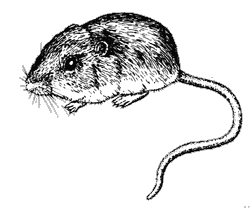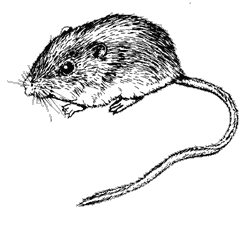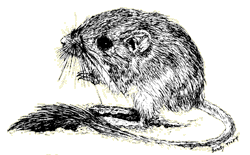Heteromyidae: Kangaroo Rats & Pocket Mice
The heteromyids are a group of rodents consisting of kangaroo rats and pocket mice. Despite their names, they are neither rats nor mice; and in spite of their mouse-like appearance, they are not closely related to any other species of North American rodent.
Kangaroo rats and pocket mice are all nocturnal, burrowing animals with external fur-lined cheek pouches for storing and transporting the seeds that are their primary food. They are all well adapted to living in arid environments since most of them never need to drink water. They also have efficient kidneys that can conserve precious fluids by concentrating the urine.
Because there are many of these little rodents and they are closely related to each other, each species has evolved with different foraging times and places, which minimizes competition. Bailey’s pocket mouse, for example, climbs up into desert wash vegetation to find seeds and berries still on the plants, while the desert pocket mouse hunts along the ground in washes and open areas for seeds. Merriam’s kangaroo rat, a creature of open, creosote flats, tends to dash from one clump of bushes to the next, overlooking seeds out in the open spaces, leaving those for other mice to find. In this way many species of heteromyid mice and rats can share the same environment.
—Pinau MerlinSonoran Desert species:
little pocket mouse (Perognathus longimembris)
Arizona pocket mouse (Perognathus amplus)
long-tailed pocket mouse (Perognathus formosus)
rock pocket mouse (Chaetodipus intermedius)
desert pocket mouse (Chaetodipus penicillatus)
Bailey’s pocket mouse (Chaetodipus baileyi)
banner-tailed kangaroo rat (Dipodomys spectabilis)
erriam’s kangaroo rat (Dipodomys merriami)
desert kangaroo rat (Dipodomys deserti)
Baja California kangaroo rat (Dipodomys peninsularis)
Order: Rodentia
Family: Heteromyidae
Spanish names: ratón (pocket mouse), rata canguro (kangaroo rat)
Distinguishing features
All three of these kangaroo rats have long tails and large hind feet with 4 toes. (Some other species have 5 toes.) They also have large heads with big eyes, small ears and external, fur-lined cheek pouches.
 |
The banner- tailed kangaroo rat is one of the largest kangaroo rats, weighing up to 4H ounces (128 g). It is light brown or buff-colored with a white underside. The tail is black towards the end, but has a white tip.
Merriam’s kangaroo rat is only about half the size of the banner-tailed rat; its tail is dark at the tip.
The desert kangaroo rat is similar to the banner-tailed in size; it also has a white tip on the tail, but its fur is more yellowish.
The Arizona pocket mouse is a small mouse with a thinly-furred tail that does not have a brushy tip. This mouse has tan- to orange-colored fur that is softer than that of many of the other species of pocket mice.
The desert pocket mouse has buff to brownish, coarse fur, and a white underside. The tufted tail is long, and has a crest of fur forming a ridge along its length.
 |
Bailey’s pocket mouse is the largest of the pocket mice, weighing up to 1K ounces (39 g). It has a long, tufted tail and coarse, grayish fur, though the color can vary considerably.
The rock pocket mouse is medium-sized (K to L ounce; 11-18 g), with rough brownish-gray fur and spine-like hairs on its rump. The long tail is tufted, with a ridge of fur running along its top.
Habitat
The banner-tailed kangaroo rat lives in open desertscrub, creosote bush flats, open grasslands and sandy places. It favors a sparse covering of grasses, interspersed with a few mesquite trees and cacti.
Merriam’s kangaroo rat is the most common and widespread kangaroo rat in the Sonoran Desert. It inhabits washes, open grassland, and sandy soils of the desertscrub.
The desert kangaroo rat is found in the driest parts of the Sonoran Desert, among sand dunes and creosote flats.
The Arizona pocket mouse and the desert pocket mouse both inhabit the sandy, open desert with sparse vegetation of grasses, mesquites, creosote bushes, and a few cacti.
Bailey’s pocket mouse is found on rocky slopes and areas with boulders and rocks mixed in among the cacti and shrubs.
The rock pocket mouse also prefers rocky slopes in the desert, lava flows, and gravelly soils. It may use crevices and cracks in rocky ledges as retreats.
Feeding
• Diet: All of these kangaroo rats are primarily seed eaters, feeding especially on mesquite beans and the seeds of native grasses. Merriam’s kangaroo rats eat a few more insects and a little green vegetation as well. The pocket mice are also primarily granivorous (seed eating), most often eating mesquite beans and the seeds of grasses, creosote bushes, and weeds. They may also eat some insects and a very little vegetation. Bailey’s pocket mice are adapted to eat jojoba nuts, which are toxic to most other mice.
• Behavior: Kangaroo rats forage around the desert at night, sniffing out buried seeds, collecting as many as they can by stuffing them into their cheek pouches. These rodents forage in fairly large areas, as they hop along with their bipedal gait. Banner-tailed and desert kangaroo rats store piles of seeds in their burrows, where the seeds can absorb up to 30 percent more moisture from the humid air. Merriam’s doesn’t store seeds in burrows, but stores them instead in shallow surface caches scattered around its home range.
The pocket mice also search for seeds, but less widely than do the kangaroo rats. They carry the seeds in their cheek pouches for transport back to the burrow, where they are cached.
Life History
The Sonoran Desert kangaroo rats are remarkable in not needing to drink water, even though their diet is almost entirely composed of dry seeds. They survive almost entirely on water metabolized from the seeds they eat. The rats prefer seeds high in carbohydrates, from which they can produce a half gram of water from each gram of seed eaten. They even bathe without water, keeping their shiny fur clean by taking dust baths in the sand.
Kangaroo rats are adapted to a bipedal gait with large, strong hind legs and big feet. They can jump up to 9 feet (2.75 m) in one bound, an effective aid in escaping predators. The long tail is used as a counterbalance while the rat hops and leaps about.
 |
These rodents have very keen hearing and are able to detect an owl’s silent approach and the movement of snakes.
Pocket mice are also well adapted to arid desert life. They seldom drink, and can conserve water in a number of ways. They spend the days underground in the burrow, where in summer the humidity is higher and the temperature lower than above ground. The entrance hole is usually plugged to keep the moisture from escaping to the dry air above. The kidneys of these rodents concentrate the urine to a viscous consistency, reducing water loss. When temperatures become extreme, some pocket mice go into a torpor, or estivate. These animals are solitary and defend small territories, often fighting when they encounter each other.
Convergent Evolution
There are many reasons why one kind of living thing may look like another. Usually it’s simply because they’re related. But sometimes an organism mimics another’s appearance, thereby deceiving an unsuspecting third party. And sometimes living things come to resemble each other by adapting in similar ways to similar habitats or ways of life—a process called convergent evolution.
Kangaroo rats are such perfect examples of desert adaptation that it’s perhaps not surprising nature has arrived at similar designs more than once—a wonderful example of convergent evolution. There are small jumping rodents very much like kangaroo rats in Old World deserts, including the jerboas and gerbils of Africa and Asia and certain hopping mice in Australia. (And in case you’re wondering, there are such things as “rat kangaroos”Down Under—but they’re something completely different!)
— David W. Lazaroff, adapted from Arizona-Sonora Desert Museum Book of Answers (Desert Museum Press, 1998)









